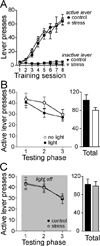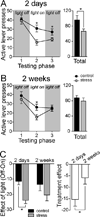Repeated social defeat stress enhances the anxiogenic effect of bright light on operant reward-seeking behavior in rats
- PMID: 25956870
- PMCID: PMC4447579
- DOI: 10.1016/j.bbr.2015.04.048
Repeated social defeat stress enhances the anxiogenic effect of bright light on operant reward-seeking behavior in rats
Abstract
Repeated stress can trigger episodes of depression, along with symptoms of anhedonia and anxiety. Although often modeled separately, anxiogenic factors potently modulate hedonic, or appetitive, behavior. While repeated stress can increase anxiety and decrease appetitive behavior, it is not clear whether repeated stress can influence the impact of anxiogenic factors on appetitive behavior. This study tests whether repeated stress shifts behavior in a task that measures anxiogenic-appetitive balance. To test this, adult male rats were trained to lever press for sucrose pellet reward, and the effect of anxiogenic bright light on this behavior was measured. The impact of the bright light anxiogenic stimulus on lever pressing was compared between groups exposed to either daily repeated social defeat stress or control handling. We found that repeated stress reduced exploration in the open field and decreased social interaction, but had minimal effect on baseline lever pressing for reward. Repeated stress substantially enhanced the effect of anxiogenic bright light on lever pressing. This effect was greater two days after the last stress exposure, and began to diminish within two weeks. These data demonstrate that the anxiogenic and anhedonic features induced by repeated stress can be separately measured, and that the impact of anxiogenic stimuli can be greatly enhanced after repeated stress, even in the face of appetitive drive. The data also demonstrate that some apparent anhedonic-like effects of repeated stress can be due to increased sensitivity to anxiogenic stimuli, and may reflect an imbalance in an appetitive approach-withdrawal continuum.
Keywords: Anxiety; Appetitive; Light; Repeated stress; Social defeat; Sucrose.
Copyright © 2015 Elsevier B.V. All rights reserved.
Figures



Similar articles
-
Modeling hypohedonia following repeated social defeat: Individual vulnerability and dopaminergic involvement.Physiol Behav. 2017 Aug 1;177:99-106. doi: 10.1016/j.physbeh.2017.04.016. Epub 2017 Apr 19. Physiol Behav. 2017. PMID: 28433467 Free PMC article.
-
Imipramine restores the long-term impairment of appetitive behavior in socially stressed rats.Psychopharmacology (Berl). 2002 Jul;162(3):232-8. doi: 10.1007/s00213-002-1093-3. Epub 2002 May 1. Psychopharmacology (Berl). 2002. PMID: 12122480
-
Ability of palatable food consumption to buffer against the short- and long-term behavioral consequences of social defeat exposure during juvenility in rats.Physiol Behav. 2017 Aug 1;177:113-121. doi: 10.1016/j.physbeh.2017.04.002. Epub 2017 Apr 7. Physiol Behav. 2017. PMID: 28396287
-
Environmental Contributions to Anhedonia.Curr Top Behav Neurosci. 2022;58:81-108. doi: 10.1007/7854_2021_289. Curr Top Behav Neurosci. 2022. PMID: 34894350 Review.
-
Peripheral and central effects of repeated social defeat stress: monocyte trafficking, microglial activation, and anxiety.Neuroscience. 2015 Mar 19;289:429-42. doi: 10.1016/j.neuroscience.2015.01.001. Epub 2015 Jan 14. Neuroscience. 2015. PMID: 25596319 Free PMC article. Review.
Cited by
-
Serotonin Signaling Trough Prelimbic 5-HT1A Receptors Modulates CSDS-Induced Behavioral Changes in Adult Female Voles.Int J Neuropsychopharmacol. 2019 Mar 1;22(3):208-220. doi: 10.1093/ijnp/pyy093. Int J Neuropsychopharmacol. 2019. PMID: 30445535 Free PMC article.
-
Non-invasive assessment of positive affective state using infra-red thermography in rats.Anim Welf. 2023 Sep 29;32:e66. doi: 10.1017/awf.2023.87. eCollection 2023. Anim Welf. 2023. PMID: 38510988 Free PMC article.
-
Cardiovascular outcomes related to social defeat stress: New insights from resilient and susceptible rats.Neurobiol Stress. 2019 Jun 6;11:100181. doi: 10.1016/j.ynstr.2019.100181. eCollection 2019 Nov. Neurobiol Stress. 2019. PMID: 31236438 Free PMC article.
-
Induction of Repeated Social Defeat Stress in Rats.Bio Protoc. 2022 Feb 5;12(3):e4306. doi: 10.21769/BioProtoc.4306. eCollection 2022 Feb 5. Bio Protoc. 2022. PMID: 35284596 Free PMC article.
-
Effects of repeated social stress on risk assessment behaviors and response to diazepam in the elevated plus maze in adult male rats.Behav Neurosci. 2025 Apr;139(2):60-73. doi: 10.1037/bne0000612. Epub 2024 Dec 2. Behav Neurosci. 2025. PMID: 39621391
References
-
- Clark LA, Watson D. Tripartite model of anxiety and depression: psychometric evidence and taxonomic implications. J Abnorm Psychol. 1991;100:316–336. - PubMed
-
- Davidson RJ, Pizzagalli D, Nitschke JB, Putnam K. Depression: perspectives from affective neuroscience. Annu Rev Psychol. 2002;53:545–574. 10.1146/annurev.psych.53.100901.135148. - PubMed
-
- Stout JC, Weiss JM. An animal model for measuring behavioral responses to anxiogenic and anxiolytic manipulations. Pharmacol Biochem Behav. 1994;47:459–465. - PubMed
-
- Desiderato O, Newman A. Conditioned suppression produced in rats by tones paired with escapable or inescapable shock. J Comp Physiol Psychol. 1971;77:427–431. - PubMed
Publication types
MeSH terms
Grants and funding
LinkOut - more resources
Full Text Sources
Other Literature Sources
Medical

